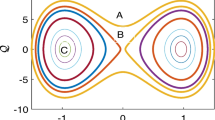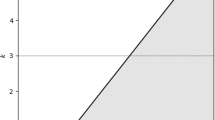Abstract
We study the dynamics of condensation of the inclusion process on a one-dimensional periodic lattice in the thermodynamic limit, generalising recent results on finite lattices for symmetric dynamics. Our main focus is on totally asymmetric dynamics which have not been studied before, and which we also compare to exact solutions for symmetric systems. We identify all relevant dynamical regimes and corresponding time scales as a function of the system size, including a coarsening regime where clusters move on the lattice and exchange particles, leading to a growing average cluster size. The second moment of the occupation numbers is a suitable observable to characterise the transition, and exhibits a power law scaling in this regime before saturating to stationarity following an exponential decay depending on the system size. Our results are based on heuristic derivations and exact computations for symmetric systems, and are supported by detailed simulation data.







Similar content being viewed by others
References
Giardinà, C., Kurchan, J., Redig, F.: Duality and exact correlations for a model of heat conduction. J. Math. Phys. 48(3), 033301–033315 (2007)
Giardinà, C., Redig, F., Vafayi, K.: Correlation inequalities for interacting particle systems with duality. J. Stat. Phys. 141(2), 242–263 (2010)
Grosskinsky, S., Redig, F., Vafayi, K.: Condensation in the inclusion process and related models. J. Stat. Phys 142(5), 952–974 (2011)
Chleboun. P.: Large Deviations and Metastability in Condensing Stochastic Particle Systems. PhD thesis, The University of Warwick, Warwick (2012).
Giardinà, C., Kurchan, J., Redig, F., Vafayi, K.: Duality and hidden symmetries in interacting particle systems. J. Stat. Phys. 135(1), 25–55 (2009)
Moran, P.A.P.: The Statistical Processes of Evolutionary Theory. Oxford University Press, Oxford (1962)
Arnoldt, H., Timme, M., Grosskinsky, S.: Frequency-dependent fitness induces multistability in coevolutionary dynamics. J. R. Soc. Interface 9(77), 3387–3396 (2012)
Reuveni, S., Eliazar, I., Yechiali, U.: Asymmetric inclusion process as a showcase of complexity. Phys. Rev. Lett. 109(2), 020603 (2012)
Reuveni, S., Hirschberg, O., Eliazar, I., Yechiali, U.: Occupation Probabilities and Fluctuations in the Asymmetric Simple Inclusion Process. arXiv:1309.2894 [cond-mat.stat-mech] (2013).
Grosskinsky, S., Redig, F., Vafayi, K.: Dynamics of condensation in the symmetric inclusion process. Electron. J. Probab. 18, 1–23 (2013)
Drouffe, J.-M., Godrèche, C., Camia, F.: A simple stochastic model for the dynamics of condensation. J. Phys. A 31(1), L19–L25 (1998)
Evans, M.R.: Phase transitions in one-dimensional nonequilibrium systems. Braz. J. Phys. 30(1), 42–57 (2000)
Godrèche, C.: Dynamics of condensation in zero-range processes. J. Phys. A 36(23), 6313–6328 (2003)
Grosskinsky, S., Schütz, G.M., Spohn, H.: Condensation in the zero range process: stationary and dynamical properties. J. Stat. Phys. 113(3–4), 389–410 (2003)
Godrèche, C., Luck, J.M.: Dynamics of the condensate in zero-range processes. J. Phys. A 38(33), 7215–7237 (2005)
Evans, M.R., Hanney, T.: Nonequilibrium statistical mechanics of the zero-range process and related models. J. Phys. A 38(19), R195–R240 (2005)
Godrèche, C., Luck, J.M.: Nonequilibrium dynamics of the zeta urn model. Eur. Phys. J. B. 23, 473–486 (2001)
Godrèche, C.: From urn models to zero-range processes: statics and dynamics. Lect. Notes Phys. 716, 261–294 (2007)
Ferretti, L., Bianconi, G.: Dynamics of condensation in growing complex networks. Phys. Rev. E 78(5), 056102 (2008)
Godrèche, C., Luck, J.M.: Condensation in the inhomogeneous zero-range process: an interplay between interaction and diffusion disorder. J. Stat. Mech 2012(12), P12013 (2012)
Jeon, I., March, P., Pittel, B.: Size of the largest cluster under zero-range invariant measures. Ann. Probab. 28(3), 1162–1194 (2000)
Armendáriz, I., Loulakis, M.: Thermodynamic limit for the invariant measures in supercritical zero range processes. Probab. Theory Relat. Fields 145(1–2), 175–188 (2008)
Beltrán, J., Landim, C.: Tunneling and metastability of continuous time Markov chains. J. Stat. Phys. 140(6), 1–50 (2010)
Beltrán, J., Landim, C.: Metastability of reversible condensed zero range processes on a finite set. Probab. Theory Relat. Fields 152(3–4), 781–807 (2011)
Beltrán, J., Landim, C.: Tunneling and metastability of continuous time Markov chains II, the nonreversible case. J. Stat. Phys. 149(4), 598–618 (2012)
Beltrán, J., Landim, C.: A martingale approach to metastability. Probab. Theory Relat. Fields. arXiv:1305.5987 [math.PR] (2014).
Schütz, G.M., Harris, R.J.: Hydrodynamics of the zero-range process in the condensation regime. J. Stat. Phys 127(2), 419–430 (2007)
Jara, M., Beltrán, J., Landim. C.: Private communication.
Waclaw, B., Evans, M.R.: Explosive condensation in a mass transport model. Phys. Rev. Lett. 108(7), 070601 (2012)
Chleboun, P., Grosskinsky, S.: Condensation in stochastic particle systems with stationary product measures. J. Stat. Phys. 154(1–2), 432–465 (2014)
Evans, M.R., Waclaw, B.: Condensation in stochastic mass transport models: beyond the zero-range process. J. Phys. A 47(9), 095001 (2014)
Hirschberg, O., Mukamel, D., Schütz, G.M.: Motion of condensates in non-Markovian zero-range dynamics. J. Stat. Mech. 2012(08), P08014 (2012)
Opoku, A., Redig, F.: Coupling Independent Walkers and the Inclusion Process. arXiv:1311.1620 [math.PR] (2013).
Carinci, G., Giardinà, C., Giberti, C., Redig, F.: Duality for stochastic models of transport. J. Stat. Phys. 152(4), 657–697 (2013)
Family, F., Vicsek, T.: Dynamics of Fractal Surfaces. World Scientific, Singapore (1991)
Grimmett, G.: Probability and Random Processes. Oxford University Press, Oxford (2001)
Acknowledgments
J.C. acknowledges funding from the University of Warwick through a Chancellor’s International Scholarship. S.G. acknowledges support by the Engineering and Physical Sciences Research Council (EPSRC), Grant No. EP/I014799/1. P.C. acknowledges support and funding from the University of Warwick, Institute of Advanced Study through a Global Research Fellowship. We are grateful for inspiring discussions with F. Redig and M.R. Evans.
Author information
Authors and Affiliations
Corresponding author
Appendices
Appendix 1: Toy Model for the Nucleation Regime
We define a toy model for the number of occupied sites after the nucleation regime of the TASIP on the lattice \(\Lambda _L=\{1,2,3,\ldots ,L\}\) with periodic boundary conditions, where the modified state variable \(\eta _x \in \{ 0,1\}\) simply indicates whether site \(x\) is occupied. We consider the simplest uniform initial distribution \(\eta _{x}(0)=1\) for all \(x\in \Lambda _{L}\). After waiting time \(T_{x}\), the mass on site \(x\) tries to jump to site \(x+1\), where \(T_{x}\) are i.i.d. random variables. This jump is successful only if \(\eta _{x+1} (T_x )=1\), i.e. the mass on site \(x+1\) has not moved before, and after the jump we have \(\eta _x =0\) and \(\eta _{x+1} =1\). This is a simplified model of the inclusion interaction of the process in the nucleation regime, and keeps track only of occupied sites. The \(T_x\) can be interpreted as the random times when the full mass in the true TASIP has moved from site \(x\) to \(x+1\). The distribution of those times is not important for our argument, we only assume that they are independent, and their order therefore corresponds to a uniform permutation. After some time all particles reside on non-successive sites and the toy model reaches an absorbing state. Such absorbing configurations are constructed by blocks in different lengths, where one block has several empty sites and only one occupied site on the rightmost site of this block. In other words, the blocks are of the form \(000\ldots 001\). We denote the length of such a block (indexed by \(n\)) by \(X_{n}\in {\mathbb {N}}\), where \(2\le X_{n}\le L\) and \(\sum _{n}X_{n}=L\).
Assume that the occupied site of one such block is \(z\), then \(\eta _{z-1}=\eta _{z-2}=\cdots =\eta _{z-k}=0\) when \(k+1\) is the size of the block. The event \(X_{n}\ge k+1\), i.e. a block size of at least \(k+1\), is equivalent to the event
since each initial particle has to jump earlier than its right neighbour, so that all the mass on these sites could move up to site \(z\).
Since the times are ordered in a uniform permutation, the probability for (39) determines
So we get the following limiting behaviour for the expectation,
Note that the lengths of successive clusters are independent, so that the \((X_n :n\ge 0)\) constitute a renewal process on \(\Lambda _L\), and
is the number of blocks at the absorbing state, which is equal to the number of remaining particles. From the standard renewal theorem (see e.g. Chapt. 10.2 in [36]) we get
where \(\mu =\mathbb {E}[X_{1}]=e\) is the expected block length. Therefore, we have an approximation of the ratio of occupied sites [see (14)]
This is very close to the observed value in Sect. 3 for small densities \(\rho \approx 1\), where we expect the toy model to give the best approximation. For very low densities \(r\) is dominated by the initial number of empty sites, whereas for high densities correlations built up over long distances leading to striped patterns, and \(r\) seems to grow slowly towards its maximal value \(1/2\) as \(\rho \rightarrow \infty \).
With the above approach, the time scale for the nucleation regime can be approximated by the maximum of the order of \(L\) i.i.d random variables \(T_{x}\). There is no evidence that the distribution of the \(T_{x}\) has heavy tails, which leads to a typical scaling of the maximum of order \(\log (L)\). This is a good approximation to the nucleation time scaling which is also supported by unshown numerical results
Appendix 2: Symmetric Random Walk with Absorbing Boundary
Consider a simple symmetric discrete-time random walk \(\{S_{n}, n\in {\mathbb {N}}\}\) with state space \(X_{m}=\{0,1,2,\ldots ,m\}\) such that \(S_{n}\in \{0,m\}\) are two absorbing states, and we define the excursion length \(T:=\min \{n\in {\mathbb {N}}: S_{n}\in \{0,m\}\}\).
One can easily check that \(S_{n}\) is a martingale, i.e. \(\mathbb {E}[S_{n}|S_{0}]=S_{0}\), and then we have by the optional stopping theorem (see e.g. Chapt. 12.5 in [36])
where \(p_{0}\) is the probability of the walker being absorbed in site 0. Assume \(S_{0}=k\), \(k\in X_{m}\), then \(\mathbb {E}[S_{0}]=k\) gives
Define a new process \(\{Y_{n}:=S_{n}^{2}-n, n\in {\mathbb {N}}\}\) which is also a martingale, since
Again, the martingale property and optional stopping theorem imply
and therefore
Rights and permissions
About this article
Cite this article
Cao, J., Chleboun, P. & Grosskinsky, S. Dynamics of Condensation in the Totally Asymmetric Inclusion Process. J Stat Phys 155, 523–543 (2014). https://doi.org/10.1007/s10955-014-0966-2
Received:
Accepted:
Published:
Issue Date:
DOI: https://doi.org/10.1007/s10955-014-0966-2




